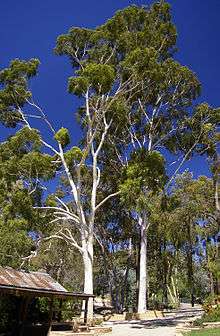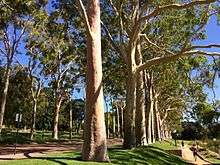Corymbia citriodora
| Lemon-scented gum | |
|---|---|
 | |
| Scientific classification | |
| Kingdom: | Plantae |
| Clade: | Angiosperms |
| Clade: | Eudicots |
| Clade: | Rosids |
| Order: | Myrtales |
| Family: | Myrtaceae |
| Genus: | Corymbia |
| Species: | C. citriodora |
| Binomial name | |
| Corymbia citriodora | |
 | |
| Corymbia citriodora, field distribution | |
| Synonyms | |
|
Eucalyptus citriodora | |
Corymbia citriodora is a tall tree, growing to 35 metres (115 ft) in height (but sometimes taller), from temperate and tropical north eastern Australia. It is also known as lemon-scented gum, blue spotted gum, lemon eucalyptus and eucalyptus citriodora.
Description
Corymbia citriodora has smooth, pale, uniform or slightly mottled bark, white to coppery in summer, and a conspicuously narrow-leaved crown which smells strongly of lemons. Pear-shaped buds are borne in clusters of three, formed in the corner of leaf and stem junctions, whilst fruit (capsules) are urn-shaped. The bark is smooth for the entire height of the tree, often powdery, shedding in thin curling flakes.[1]
It prefers lighter, slightly acidic loamy soils and occurs in dry sclerophyll forest and woodlands in hilly country. Corymbia citriodora has a lignotuber. Flowering has been recorded in January, April, May, June, July, August, October and December.
Range

Plants of C. citriodora are naturalised in the Darling Range near Mundaring, Western Australia and by planting to suburban New South Wales, South Australia and Victoria.
Kings Park in Perth has a famous, beautiful avenue of this species planted many years ago, but it has spread to become a serious weed.[2]
Corymbia citriodora is an important forest tree, in demand for structural timber and for honey production. It also is popular in horticulture both within Australia and overseas. The name Corymbia citriodora comes from the Latin citriodorus, which means lemon-scented.
Many naturalists and conservationists do not recognise the Corymbia genus and still categorise its species within Eucalyptus.[3] Corymbia is a genus of about 113 species of tree that were classified as Eucalyptus species until the mid-1990s. It includes the bloodwoods, ghost gums and spotted gums. The bloodwoods had been recognised as a distinct group within the large and diverse Eucalyptus genus since 1867. Molecular research in the 1990s, however, showed that they, along with the rest of the Corymbia section, are more closely related to Angophora than to Eucalyptus, and are probably best regarded as a separate genus. All three genera—Angophora, Corymbia and Eucalyptus—are closely related, often difficult to tell apart, and are still commonly and correctly referred to as "eucalypts".
Essential oil

The essential oil of the lemon-scented gum mainly consists of citronellal (80%),[4] produced largely in Brazil and China.[5] Unrefined oil from the lemon eucalyptus tree is used in perfumery, and a refined form of this oil is used in insect repellents, especially against mosquitoes. The refined oil's citronellal content is turned into cis- and trans- isomers of p-menthane-3,8-diol (PMD), a process which occurs naturally as the eucalyptus leaves age. This refined oil, which includes related compounds from the essential corymbia citriodora, is known widely by its registered tradename, "Citriodiol", but also by generic names which vary by region: "oil of lemon eucalyptus" or "OLE" (USA); "PMD rich botanic oil" or "PMDRBO" (Europe); "PMD and related oil of lemon eucalyptus compounds" (Canada); Extract of Lemon Eucalyptus (Australia). Pure PMD is synthesized for commercial production from synthetic citronellal. Essential oil refined from the leaves of the tree can contained up to 98% citronella content. The smell of the essential oil can vary, but mostly includes a strong odor compatible alone to citronella oil, with a slight hint of lemon scent.
A study comparing mosquito repellents found that products using the oil of lemon eucalyptus were effective at driving mosquitos away from a human hand.[6]
- Features of the lemon-scented gum (Corymbia citriodora)
 Trunk bark
Trunk bark Shedding trunk bark
Shedding trunk bark Shedding trunk bark
Shedding trunk bark Juvenile leaves
Juvenile leaves Adult leaves
Adult leaves Fruit (gum nuts)
Fruit (gum nuts) Extracted essential oil
Extracted essential oil
See also
References
- ↑ Factsheet - Corymbia citriodora
- ↑ Hussey et al., (1997) Western weeds : a guide to the weeds of Western Australia South Perth, W.A.: Plant Protection Society of W.A. : 1997. ISBN 0-646-32440-3, 1997
- ↑ Brooker & Kleinig (2006) Field Guide to Eucalypts. 3rd ed.
- ↑ Boland, D.J. et al., Eucalyptus Leaf Oils - Use, Chemistry, Distillation and Marketing, ISBN 0-909605-69-6.
- ↑ Lawless, J., The Illustrated Encyclopedia of Essential Oils, ISBN 1-85230-661-0
- ↑ Stacy D. Rodriguez; Lisa L. Drake; David P. Price; John I. Hammond; Immo A. Hansen. 2015. The Efficacy of Some Commercially Available Insect Repellents for Aedes aegypti (Diptera: Culicidae) and Aedes albopictus (Diptera: Culicidae) Journal of Insect Science 15 (1): 140. DOI: https://doi.org/10.1093/jisesa/iev125